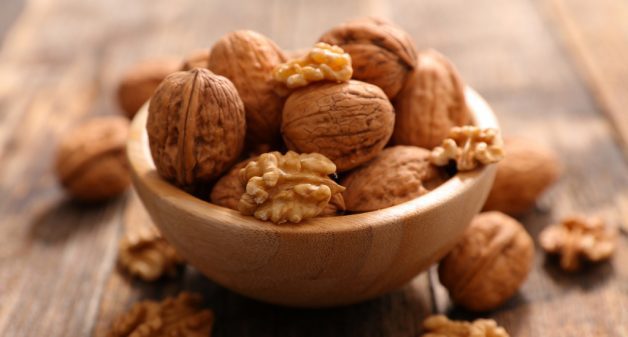On the lush outskirts of Srinagar, where green trees turn yellow with the onset of fall, Ghulam Mohammad Dar stands guard amidst his ancestral walnut grove. The moment a crow or any other pesky, nut-cracking bird dares to fly near one of his 17 trees, he waves his hands and shouts them away.
It’s a never-ending task, but these days it’s the least of his worries.
The walnut market in India
Despite walnuts becoming increasingly popular with urban India – especially after being dubbed a “super food” – the walnut market is a tough one for local growers. Though Dar produces hundreds of kilograms of walnuts, doing so is becoming more expensive, and increasing production costs are denting his revenue.
“Every year I expect good returns. Though the market is good, it’s never in favor of the growers,” said Dar.
Where do walnuts come from in India?
More than 90% of the country’s walnuts come from Kashmir in three varieties – Wonth, Kagazi and Burzul. But now thousands of walnut farmers in the Kashmir valley, like Dar, aren’t finding it a profitable crop, despite good demand. Many are considering giving up walnut farming.

“I’ve been tending to these trees for about a decade after my father’s death. But gradually I’m losing interest in this ancestral livelihood,” lamented Dar.
The state of walnut farming: Hard-nut, hard-harvest
The short walnut harvest begins in the last week of August and goes through the end of October. Though the maintenance of walnut orchards is minimal compared to other fruits, such as apple or cherry, harvesting the nut – by threshing – is labor intensive and therefore expensive.

Traditionally a couple of skilled thrashers, known locally as chanawael, climb up large branches and thrash the large canopy of the tree with long tapering wooden poles made from willow or wicker. The falling walnuts, covered with green flesh, are collected in gunny bags for further processing. According to the farmers, the process is expensive.
“The rate for two thrashers per day is around Rs 3,000. Besides, one has to employ three or four laborers to collect the fruits,” Mohammad Shafi, a walnut dealer from Nishat on the outskirts of Srinagar, told VillageSquare.

Using traditional knives, the farmers or skilled labor peel off the green fleshy cover of the fruit. The shelled stones are then sun dried for several days before being sent to the market.
A long wait to reap rewards with walnut cultivation
A big challenge with walnut cultivation is the long gestation period, never mind the large space the trees occupy. A walnut tree takes 15 to 17 years to develop a sizable canopy and fruit.
It’s a hard reality that many walnut farmers face since the option of apple cultivation is more lucrative. Though the other crops have a short gestation period, those who grow fruits such as plum face market uncertainties too. However, walnut farmers are affected more.
“People are earning handsome amounts from apple and other fruits, which have shorter gestation periods and better prospects compared to walnut. One has to wait for very long to reap the fruit,” said Abdul Karim Khatana, a walnut farmer on the outskirts of Srinagar. “Under these circumstances it’s hard to continue with walnut farming.”
The state produces 60,000 tons of walnut. Yet, amidst the production and consumption of thousands of metric tons of the shelled fruit, farmers rue that only a part of the revenue trickles down to them.

“Traders buy the nuts for a much smaller amount from us and sell it in kilograms at a good rate. I’ve been selling the fruit at constant rate of Rs 150 – 200 per hundred walnuts for many years,” said Khatana.
Traders and wholesale dealers not only blame high input costs for the low returns, but also increased transportation rates and stiff competition from imported walnuts.
Walnut farmers in India seek government support
While India exports walnuts to Germany, Italy and a dozen other countries – in 2020-21 1,070 tons were exported – it also imports walnuts from Chile, the USA, UAE, Vietnam and Afghanistan. With the current political climate in Afghanistan preventing imports of Afghan walnuts, there is a glimmer of hope the upcoming festive season in India will give the farmers better returns this year.
But for the long term, Kashmiri walnut farmers feel that a minimum support price (MSP) is the way forward, especially with market uncertainty from the pandemic and low tourist numbers dealing them a double whammy.

“Authorities should safeguard the interests of this heritage crop – like the apple, pashminas and carpets, they should introduce MSP for walnuts,” said walnut dealer Mudasir Ahmad Sheikh from Nishat, Srinagar.
New varieties may offer new hope for India’s walnut farmers
But science might offer the most hopeful solution.
The fruit sciences department at Sheri Kashmir Institute of Sciences and Technology (SKAUST), Shalimar, has released two grafted varieties – Hamdan and Sulaiman – with a considerably shorter gestation period of three to four years. Not only that, the new varieties have a smaller canopy – about 9 square meters compared to the 18 square meters of traditional trees.
So far the farmers say the yields of these newly grafted varieties are low. But Abdul Majeed, a professor at SKAUST, said the department is working on increasing them.
Nasir Yousufi is a journalist based in Kashmir. Views are personal.








